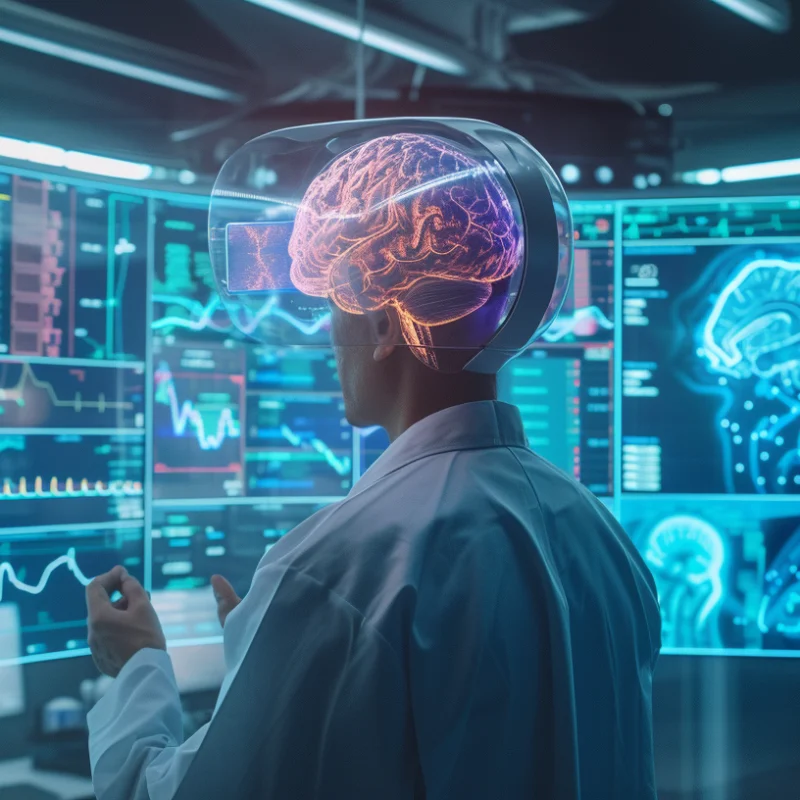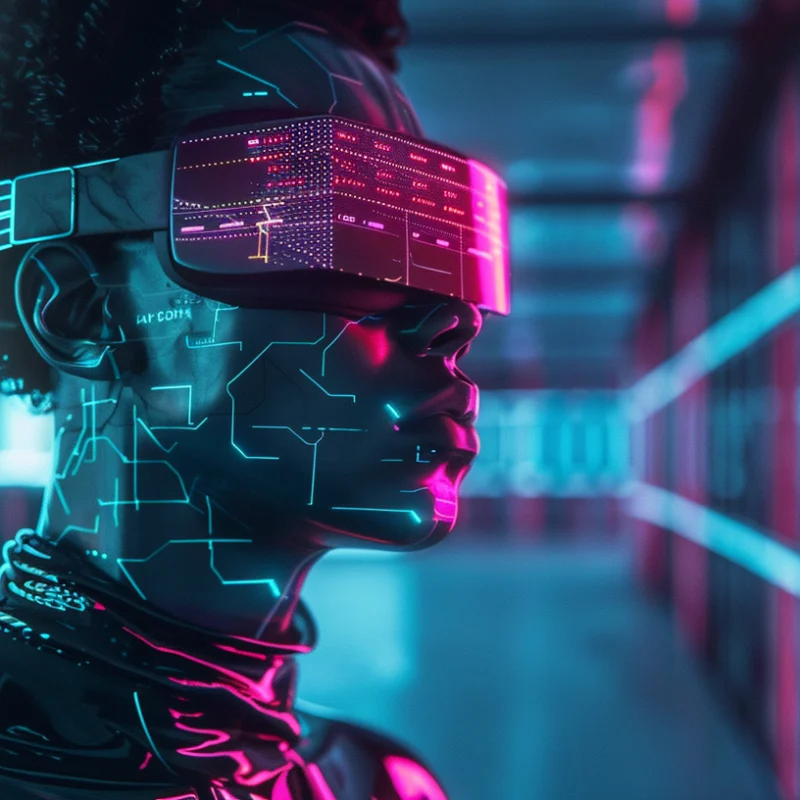VR Training: The Future of Professional Development
Efficient learning with VR training - welcome to the future
The world of learning has changed dramatically in recent years and is becoming more effective and exciting with the latest technologies.
One of the latest achievements in this area is VR training. Thanks to virtual reality technology, participants can immerse themselves in an immersive environment and test and expand their knowledge in realistic scenarios.
VR training is revolutionizing learning and offers many benefits, which are explained in more detail in this article. We will look at how VR training works, the benefits and the future of this technology.
We will also explore where VR training can be used and what opportunities exist to make learning more effective and fun.
Key Takeaways:
- VR training allows for an efficient and exciting learning environment through the use of virtual reality technology.
- Participants can test and expand their knowledge in realistic scenarios.
- VR training offers many advantages over traditional learning methods and has great potential for the future.
What is VR training?
VR training refers to the use of virtual reality in training scenarios. It is a relatively new form of learning that allows participants to be placed in an immersive environment.
By immersing themselves in a virtual world, participants can have a realistic training experience that is similar to real life.
With the help of VR goggles, participants are transported into a virtual reality consisting of 3D graphics. This allows them to interact and learn in a simulated environment.
VR Training can be used for a variety of applications, from professional training to medical education. It’s an exciting way to maximize learning and improve participants’ skills.
The advantages of VR training
Immersive learning through VR technology has numerous benefits:
- A more intense learning experience thanks to virtual reality
- Better recall through hands-on practice in realistic scenarios
- More effective learning through more involvement of the senses
- More motivation through interactive elements and gamification
- Reduced costs due to the possibility of conducting virtual instead of physical trainings
Thanks to these advantages, companies and training providers can design their learning programs more effectively and cost-efficiently, resulting in better learning success.
Possible applications of VR training
A VR training is a novel technology that can be used in various fields to increase the quality of training and education. Some of the areas where VR training is already being used successfully include:
- professional development and training
- Healthcare
- Industrial sector
In professional development and training, employees can undergo interactive training in a safe and controlled environment to learn new skills and techniques.
In healthcare, medical professionals can experience realistic scenarios and improve their skills without putting real patients at risk.
In the industrial sector, workers can prepare for complex situations and hazardous environments before they have to experience such situations in reality.
3D simulation technology can be used to create realistic scenarios to enhance participants’ experience and understanding.
For both training and evaluation purposes, VR training provides a safe, cost-effective, and realistic environment that allows participants to acquire and reinforce practical skills.
The development of VR training platforms
VR training is a relatively new technology, but a number of platforms have already developed that are specifically designed for this application area.
These platforms offer a variety of features that enable developers to create immersive and interactive learning experiences.
Most of the VR training platforms currently available have been developed specifically for vocational training. For example, they offer training on safety-related topics or on working with specific machines.
Some platforms also include healthcare training, including surgical techniques and diagnostic methods.
One of the most important developments in VR training is the ability to create 3D simulations. This type of simulation provides a realistic environment in which learners can simulate and practice complex workflows.
One example is flight simulations, where pilots can learn how to react in different situations in a safe environment.
Advantages of a dedicated VR training platform
- Ease of use: Most VR training platforms are very intuitive. This allows users to quickly and easily go through training and focus on the learning content.
- Flexibility: VR training platforms can be customized as needed. This means that training can be created for a wide range of industries and activities.
- Interactivity: The biggest advantage of VR training is the ability to create interactive training. Learners can work in a realistic environment and interact with the objects and systems they will later encounter in their work.
Interactive VR training
One of the greatest strengths of VR training is the ability to incorporate interactive elements into training. This makes learning not only more effective, but also more fun. By actively engaging the learner in the training, they can improve their experience and skills in a safe environment.
One example of the interactivity of VR training is the simulation of real-world scenarios. In the healthcare industry, doctors and nurses can simulate and train emergency situations as they might occur in a real hospital. Through the use of VR goggles, they are transported into a virtual reality where they can experience the situation for themselves and react accordingly.
Interactive elements in VR training courses
In addition, interactive elements such as quizzes or games can be integrated into the VR training. Learners can improve their skills playing games or answer quizzes to test their knowledge. Adding rewards or points for successfully completing tasks can also increase learner motivation.
- Quiz questions
- Games
- Rewards and points
Overall, interactive VR training provides an immersive learning experience that goes beyond traditional training. Integrating interactive elements can make learning more effective and fun.
Gamification in VR training
Gamification has become an important technique in the modern learning landscape. The use of playful elements allows learning to be a fun experience.
In VR training, there are numerous opportunities to integrate gamification and make training more effective. An example of this is incorporating points and rewards when the student reaches certain goals.
Another example is the use of leaderboards. Displaying student results creates competition, which can increase motivation.
The advantages of gamification in VR training
- Gamification can help increase student motivation and ensure long-term engagement.
- It can also help make learning a fun experience and encourage students to apply what they learn in real-world situations.
- By integrating playful elements, complex information can be broken down into appealing and easily digestible bites.
All in all, gamification is an important part of VR training. It helps make learning more effective and fun, and can help increase long-term motivation.
The future of VR training
There is no doubt that VR training is revolutionizing the way we impart and acquire knowledge. We are likely to see more of this technology in the future as it expands to an even broader range of industries and use cases.
One potential area where VR training could be developed further is in the use of artificial intelligence (AI) for personalized training. By tracking progress and learning, AI can automatically make adjustments to improve learning.
Another potential trend is the use of VR training for remote collaboration. The immersive experience of VR can help employees meet in a virtual environment and work together on projects as if they were in the same room.
Overall, there are countless ways VR training can be used in the future. The technology is expected to become more advanced and user-friendly, leading to greater adoption and diffusion.
The challenges of VR training
Although VR training offers many benefits, there are also challenges that must be considered.
- Cost: Implementing VR training can be expensive. Purchasing VR goggles and screens and developing VR content requires significant investment.
- Technology Update: VR technology evolves rapidly and requires regular updates and maintenance.
- Acceptance: Not all participants are ready to engage in the immersive experience of VR training.
To overcome these challenges, companies can draw on a variety of approaches. For example, they may opt for lower-cost VR alternatives or phase in the use of VR training. It is also helpful to transparently communicate the benefits of VR training and make the training interactive and fun to increase adoption.
But: The opportunities outweigh the challenges.
Overall, the benefits of VR training far outweigh the challenges. VR technology offers a unique opportunity to create realistic training scenarios and make learning more effective and exciting. With the right strategies and approaches, the challenges of VR training can be effectively overcome.
Want to learn more about RPA & AI?
Conclusion: VR training
VR training is undoubtedly the future of training and has the potential to make learning more effective and fun. The immersive experience offered by VR technology can improve understanding and learning outcomes.
In the future, there will likely be more VR training platforms that specialize in specific industries and topics, expanding the possibilities for interactive and gamified training.
However, there are challenges that must be considered. The cost of implementing VR training can be high and it often requires technology upgrades. In addition, it is important to consider the acceptability of VR training to learners.
Overall, however, the potentials of VR training offer exciting developments and a promising future for training and education.
VR Training FAQs
VR Training is a form of learning where participants are immersed in a virtual reality and have an immersive training experience.
VR training enables more effective learning and leads to better learning outcomes. Realistic scenarios are created through immersive VR technology.
There are now various platforms that have been developed specifically for VR training and are being continuously refined.
Interactive elements in VR training make learning even more effective by allowing participants to actively participate in training and develop hands-on skills.
The future of VR training will be shaped by new technologies and trends that will make learning even more effective and personalized
You might also be interested in
Chief AI Officer (CAIO): The new key position generated by Midjourney Have you ever wondered who is responsible for the use of artificial intelligence (AI) in a company? Get to know the Chief AI Officer or Chief Artificial Intelligence Officer (CAIO), an increasingly important position in today’s corporate world. In



